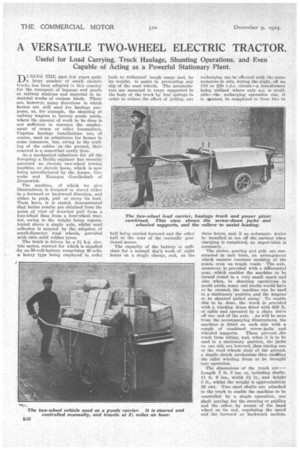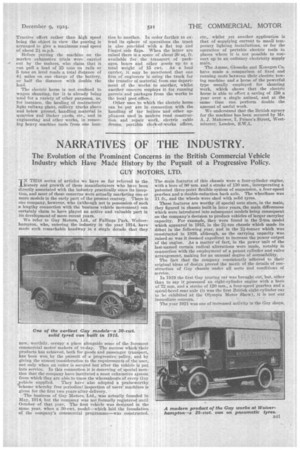A VERSATILE TWO-WHEEL ELECTRIC TRACTOR.
Page 24

Page 25

If you've noticed an error in this article please click here to report it so we can fix it.
Useful for Load Carrying, Truck Haulage, Shunting Operations, and Even Capable of Acting as a Powerful Stationary Plant.
DRING THE past few years quite a large number of small . electric traek3 has been adopted in this country for the transport of luggage and goods at railway stations and material in industrial works of various kinds. There are, however, many directions in which horses are still used for haulage purposes, as, for example, the shunting of railway wagons in factory goods yards, where the amount of work to be done is not sufficient to warrant the employment of steam or other locomotives. Capstan haulage installations are, of course, used as substitutes for horses in some instances, .but, owing to the trailing of the cables on the ground, their renewal is a somewhat costly item.
As a mechanical substitute for all the foregoing a Berlin engineer has recently patented an electric two-wheel towing machine, or electric horse, which is now being manufactured by the Amme, Giesecke and Konegen Gesellschaft of Brunswick.
The machine, of which we give illustrations, is designed to travel either in a forward or backward direction, and either to push, pull or carry its load. Tests have, it is stated, demonstrated that.better results are obtained from the point of view of drawbar pull from a two-wheel than from a four-wheel tractor, owing to the weight being concentrated above a single axle, whilst road adhesion is secured by the adoption of small-diameter road wheels, provided with twin solid rubber tyres.
The truck is driven by a 31h.p. electric motor, current for which is supplied -by an 80-volt battery comprising 40 cells, a heavy type being employed in order both to withstand rough usage and, by its weight, to assist in preventing any slip of the road wheels. The accumulators are mounted in trays supported in the body of the truck by.. leaf springs in order to reduce the effect of jolting, one half being carried forward and the other half at the rear of the centrally positioned motor.
The (rapacity of the battery is suffident for a normal day's work of eight hours on a single charge, and, as the
recharging can he effected with the accumulators in situ, during the night, off an 110 or 221) v.d.c. circuit—a transformer being utilized where only a.c. is available—the recharging operation can, it is (*aimed, be completed in from two to three hours, and, if an automatic device be installed to cut off the ,current when charging is completed, no supervision is necessary.
The motor, gearing and axle are constructed in unit form, an arrangement which ensures constant meshing of the gears, even on rough roads. The axle, moreover, is provided with a differential gear, ,which enables the machine to be turned round in a very small space and also when, in shunting operations in goods yards, many rail tracks would have to be crossed, the machine can be used in a stationary position and the wagons' to be shunted pulled along: To enable this to be done, the truck is provided with a winding drum fitted with 650 ft. of -cable and operated by a chain drive off one end of the axle. As will be seen from the accompanying illustrations, the machine is fitted on each side with a couple of combined screw-jacks and wheeled supports. These prevent_the truck from tilting, and, when it is to be used in a stationary position, the jacks on one side are lowered, thus raising one of the road wheels clear of the ground, a simple clutch mechanism then enabling the cable winding drum to be brought into operation.
The dimensions of the truck are :Length 7 ft. 3 ins, or, including shafts. 11 ft. 9 ins., width 34 ft., and height 3 ft„ whilst the weight is approxiniately 32 cwt. Two steel shafts are attached to the truck to enable the machine to be controlled by a single operation, one shaft serving for the steering or guiding and the other, -by means of the hand wheel on its end, regulating the speed and the forward or backward motion. Tractive effort rather than high speed being the object in view the gearing is .arranged to give a maximum road speed of about 2+ m.p.h.
Before putting the machine on the market exhaustive trials were carried out by the makers, who claim that it can pull a load of 25 tons On rails or .5 tons on level roads a total distance of 41 miles on one charge of the battery, or half the distance with double the load.
The electric horse is not confined to wagon shunting, for it is already being need for a variety of other purposes, as, for instance, the hauling of contractors' light railway plant, colliery trucks above and below ground, handling material in quarries and timber yards, etc., and in • engineering and other works, in removing heavy machine tools from one low. tion to another. In order further to extend its sphere of operations the track is also provided with a flat top and tinged side flaps. When the latter are raised there is a. space of about 20 sq. ft. available for the transport of packages, boxes and other goods up to a total weight of 15 cwt. As a load carrier, it may be mentioned that one firm of engineers is using' the truck for the transfer of material from one department of the works to another, whilst another concern employs it for running Parcels and packages from the works to the local post office.
Other uses to which the electric horse can be put are in connection with the handling of tar boilers and other appliances used in modern road_ construction and repair work, electric cable drams, portable clerk-of-works offices, etc., whilst yet another application is that of supplying current to small temporary lighting installations, or for the operation of portable electric tools in places where it is not possible to connect up to an ordinary electricity supply main.
The Amme, Giesecke and Konegen Co. have made a comparison of fixed and running costs between their electric towing machine and a horse of the powerful type usually employed for shunting work, which shows that the electric horse is able to effect 4 saving of 1.50 a year over a single animal, and at the same time can perform double the amount of useful work. We understand that the British agency for the machine has been secured by Mr. A. J. Makower, 7, Prince's Street, Westminster, London, SAVA..






























